Circling - Origins and Meaning
As a wedding rabbi for interfaith couples, I help my brides and grooms carefully think through all the Jewish wedding rituals and customs so that their Jewish-interfaith ceremony will be the best reflection of them as a couple, and of the traditions they hold dear. Whether it’s in Ohio, Kentucky, Michigan, or Pennsylvania, my couples have had all kinds of different reactions to this widely-recognized Jewish wedding custom.
The circling ritual is just one of those things that almost everyone associates with a Jewish wedding. Yet, about half my couples opt out of circling under the chuppah. Let’s take a look at the roots of this custom, and in the next post, we’ll talk about why couples choose to include it, or to leave it out. In the final blog post on circling, we’ll discuss ways that today’s couples choose to modify and explain circling to suit their own ceremonies.
Mara and Danny circled one another.
Origins
The origins of circling in Jewish weddings trace back to protective rituals in Alsace around 1560. Rabbi Naphtali Hirsch ben Elieser Treves noted a custom where a circle was drawn around women in childbirth to protect them and their newborns from demons and other supernatural scary stuff. Presumably, it was a folk concern that at the most vulnerable and emotional times of our lives, we are vulnerable to all kinds of evil influences - from supernatural to internal.
Even if this circle-drawing had a placebo effect - by soothing the woman’s family, or by reassuring the woman herself - circling proved to have such powerful effects that it was continued and passed down through the generations. This protective gesture continued through the centuries, with illustrations and accounts reinforcing its significance. Protective bracelets and amulets are just one way it continues today. It’s no surprise that, at the very fragile beginning of a couple’s married lives together, standing in their brand-new household represented by the chuppah, there would be a communal impulse to somehow protect them - and for them to protect one another and their new household.
Of course, circling isn’t all pagan or cultural superstition. We read about circling in the Hebrew Bible as a protective measure, too. Yes, even for weddings!
Biblical verses like Jeremiah 31:22 and Hosea 2 add depth to the ritual, mentioning circling in contexts of betrothal.
Besides the Bible, symbolic circling is a common practice in other parts of Jewish life. On Simchat Torah, we dance in circles with the Torah to celebrate how it encompasses every area of our lives. Circles are part of Sukkot rituals, too, and, of course, the Torah is carried in a circle every Shabbat so that the congregation can admire it. Round challahs are baked at the Jewish New Year to symbolize the circular nature of life, the world, and all creation.
Speaking of Creation, there is a reason for the number 7 - Our tradition tells us that God created the world in 7 days, at which point it was perfect - Shalem - which also means whole. Shalem shares a root with Shalom, which means peace. You can see the connection now, right? Additionally, the 7 wedding blessings parallel the 7 circles. On your wedding day, you and your beloved are participating in an act of creation - the creation of a new home, which is just as important as the creation of the world. In fact, it’s like the creation of your own tiny world, right there beneath the chuppah - the two of you, in it for the long haul, against the world.
The simplicity of the circling ritual adds to its charm. Like putting up a chuppah, this ritual can be done anywhere, with no equipment. Traditionally, this is a gendered ritual - the bride walks around the groom, creating a sacred space under the chuppah. The choice of including or excluding parents can spark discussions, allowing couples to personalize this meaningful act. It's not uncommon to witness this ritual accompanied by the gentle glow of candles held by mothers.
But don’t worry - nobody will notice or care about strict gender roles with regard to this ritual. It’s beautiful regardless of whether a woman or man is performing it. Many couples these days include both bride and groom! Same-sex couples also observe it, making decision about who walks in circles, when, and where, according to what best suits them.
Variations
Even among Orthodox communities, variations of the circling ritual abound, showcasing the diversity within Jewish traditions. This is a perfect illustration of how there is no one “right” way to do a Jewish wedding!
While many traditions have the bride’s mother walking alongside her while she circles the groom, others include both the bride’s mother and the groom’s mother. Oftentimes, the mothers will carry something symbolic, like a candle. The candle, in particular, is symbolic of light and the idea that when light is shared it only increases, never diminishes. The Skver and Lubavitch traditions involve all four parents accompanying the bride during the circle, creating a unique and inclusive moment.
Are you and your fiance/fiancee planning a Jewish or interfaith wedding ceremony? Would you like to chat with a rabbi who understands what it’s like, and knows how to help? Contact me!


